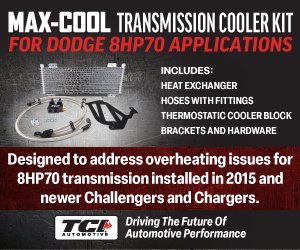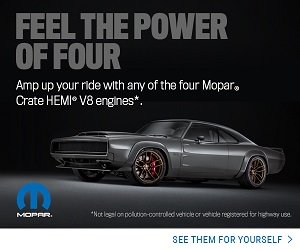
As an early twenty-something student sitting in AUT126, Engine Principles, I eagerly hung on each word of Ali Afshar, my college automotive professor. Except for Mrs. Dorchester, my 2nd-grade teacher, Mr. Afshar was the best instructor I ever had. He was a former Ford and Walker Exhaust engineer, and he approached everything from an engineering viewpoint. While Mr. Afshar is no longer with us, lectures from all the classes I had with him remain burned in my memory.

Above: Holley has introduced a bolt-on lower support structure for Gen III Hemis that had non-structural aluminum or stamped steel pans swapped in place of the factory pan.
Mr. Afshar explained, “Many manufacturers have developed structural one-piece cast aluminum or composite oil pans. Many are designed to contribute stiffness to the engine block and transmission via powertrain bending modes.” The powertrain bending modes relate to noise, vibration, and harshness (NVH) concerns. While such a statement seemed hard to believe, it continues to be correct more than three decades after hearing his initial message.
Above Left: The structure support attaches to the Hemi and the transmission bell housing. Above Right: A raised rail surface ensures a proper clamping area onto the replacement oil pan rail.
The Gen III Hemis come from the factory with structural cast aluminum (or composite) pans, but with many engine swaps, an aftermarket stamped-steel or non-structural aluminum oil pan is required to fit the Hemi around the k-member. Unfortunately, these pans do not provide the structural support of a structural cast-aluminum pan. As a result, Holley has introduced a lower structure support bracket (part no. 302-65) to return the rigidity between the block and the transmission.
Above Left: The support covers the bell housing opening to reduce the entrance of debris. Above Right: Holley designed the support to connect several bell housing designs with multiple mounting points.
The lower support fits all 2003 and up Gen III Hemi engines. Also, the lower support mounts to all the typical Mopar transmissions: TR-6060, NAG1, 545RFE, 8HP70, 8HP90, 9HP75, A727, 46RE, 46RH, and other aftermarket units. Additionally, the support works with Lakewood bell housings: (part nos. LK7000 or LK7000K) attached to a Mopar 3-speed (A-230), 4-speed (A-833), or Tremec TKO/TKX transmissions.
The rigid support can be painted to match the engine or mounted in its natural as-cast aluminum finish. Once installed, the support covers the lower portion of the bell housing, which reduces the entrance of debris into the inspection hole in the housing. The bracket comes with all the fasteners to install it to the transmission/bell housing and the oil pan.

Above: The lower structure support (blue) returns the engine’s rigidity lost after removing the structural factory aluminum or composite oil pan.
Holley has tested the lower support on the following oil pans:
• Holley (part nos. 302-60 and 302-61)
• Weiand (part nos. 5050WND and 5051WND)
• White Box (part no. WB11010)
• Mopar PN (part no. 4893207AA)
If a Hemi engine swap is in your future, use the aftermarket steel pan to fit the engine into your ride and pick up a Holley lower structure support bracket to reinstall the rigidity. For additional information, contact the Holley representatives, and to purchase a lower structure support, check out Holley’s website or your favorite parts retailer.











